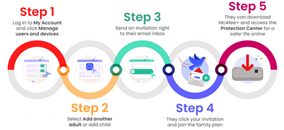
Smart speakers. Banking online. Location tracking. If you are a senior adult, there’s no doubt, the digital leaps and bounds you’re asked to consider each day can be daunting. If you are the child of a senior adult trying to make digital life more accessible, helping your parent consistently stay safe online can also be a challenge.
According to a recent Pew study on the topic, senior adults continue to become more digitally connected, but adoption rates continue to trail younger users, and digital divides remain. The study also revealed that 77% of older adults needed assistance in learning how to use technology.
As a senior, it’s easy to feel intimidated and even try to avoid technology altogether as a safety plan. However, more healthcare, banking, and retailers become almost 100% digital, opting out of digital life is becoming impossible.
Still, there’s a way forward. As with any challenge, it’s best to begin one step at a time. First, put your stake in the ground by committing to increase your awareness and consistency in the digital realm. Doing so will help you reduce your fear about potential data breaches, malware attacks, or worse, falling prey to an online scam. Here are seven more ways to build upon your privacy path.
Online protection software safeguards your privacy while also looking after your privacy too. McAfee+ Family plans include personalized protection for each member of the family, including older family members outside the home. For example, a grandparent can set up and manage their own protection for their identity, privacy, computers, and phones. And inviting a grandparent onto the plan is as simple as sending an email.

Updating your passwords regularly is an online privacy gamechanger. The only problem? It’s tough to remember all those passwords, so who wants to risk changing them, right? Consider a password manager (find the software packages that have a password manager built-in). Your Password Manager (PM) stores then populates the username and password fields every time you log on to a favorite site or app. Better yet, it makes changing your password an easy task since you don’t need to do any remembering—your PM does it all for you.
What in the world? 2FA sounds complicated! Don’t worry, it’s not. Opting for 2FA means that before logging onto your account, you will have one more step to verify it’s you logging on. When given this privacy option, take it. Commonly, the 2FA process is a code generated by a smartphone app—no biggie. If you want to try, go to your settings in your favorite apps, such as Google or Facebook, and turn on the 2FA option.
Along with strong passwords, updating your software is a front-line defense against identity theft and fraud. Installing software updates (those pesky pop-up notices that are critical to your privacy) is essential in securing your IoT devices, PCs and phones, and the social media, banking, and healthcare portals connected to them.
5. Use a Virtual Private Network (VPN).
If we could write this one tip down a hundred times without losing our readers, we surely would. Every senior adult needs a VPN for practical, powerful privacy protection and peace of mind. A VPN keeps credit card and personal info contained in a secure network and away from prying eyes.
Fraudulent emails connected to fraudulent websites can look very legitimate. A secure website will have an “HTTPS” in the browser’s address bar. The “s” stands for “secure.” If the web address or URL is just HTTP, it’s not a secure site. Still unsure? Read reviews of the site from other users before making a purchase. Never send cash, cashier’s check, or a personal check to any online vendor. If purchasing, always use a credit card in case there is a dispute. Stay up-to-date on scams that target seniors specifically. Lately, elder scams have been constructed around COVID, dating apps, tax returns, employment, and, of course, the common military catfish scams.
Like it or not, companies gather, share, and sell plenty of information about us online. Among them, online data brokers that collect information about people from public records and third parties, like shopping information from the discount cards we use to get deals at the supermarket or drug store. They compile this information and post it online for anyone to see, for a price. And they’ll sell it to anyone. That includes marketers, advertisers, and even bad actors who use it for scams and to help them commit identity theft. You can clean up these digital breadcrumbs, though. Our Personal Data Cleanup scans some of the riskiest data broker sites and show you which ones are selling your personal info. We’ll also provide guidance on how you can remove your data from those sites and with select products, we can even manage the removal for you.
When trying to boost your digital skills, don’t forget about all the amazing instructional content at your fingertips. A quick search of YouTube will render easy-to-understand videos on how to do just about everything (including install security software, change your router password, secure the smart devices in your home, and how to adjust your privacy settings on any device).
Learning or building a new skill isn’t always easy, but if you stop to think about it, as a senior, you’ve gained so many skills over your lifetime (far more than your juniors). So, practically speaking, building up your tech skills is one is just one more task to ace. So, lean into the challenge, have fun learning, and don’t hesitate to ask for help if you need it.
The post 7 Savvy Ways Senior Adults Can Safeguard Digital Privacy appeared first on McAfee Blog.